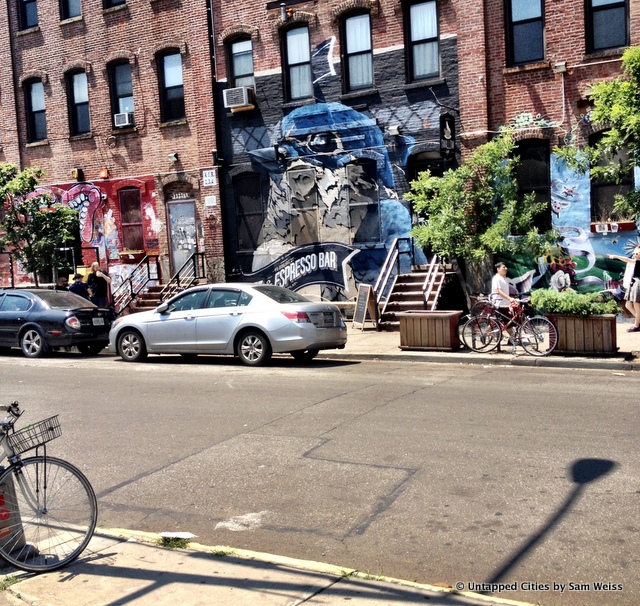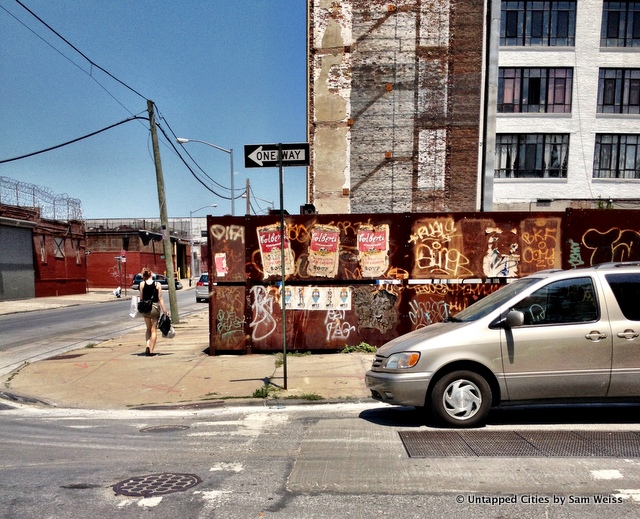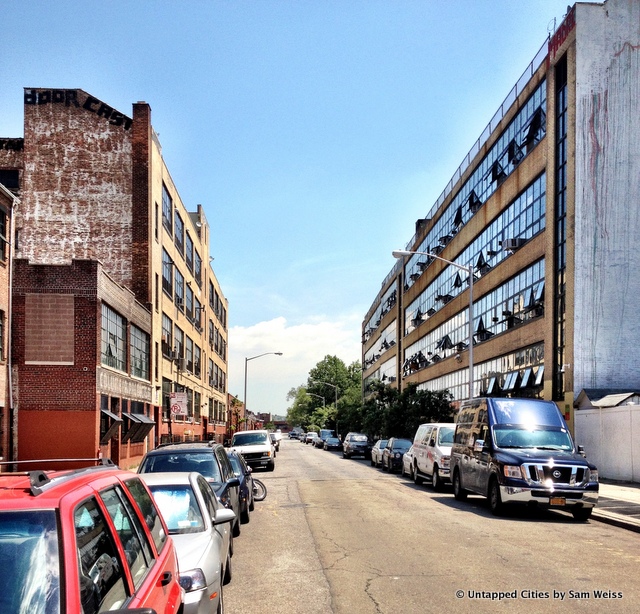
Swallow Café and other businesses on Bogart Street
How does a sparsely inhabited industrial zone become one of New York City’s blossoming cultural hubs?
The Morgan Avenue area of East Williamsburg/Bushwick is a hotbed of artists, musicians, and other young Brooklynites. Morgantown, as it’s sometimes called, is lined with hip bars, gourmet restaurants, health food stores, art galleries, and converted factory apartment buildings. Surrounding this island of culture, however, is block after block of factories and warehouses, some operational and many empty.
 Street art and industrial buildings at McKibbin and White Streets
Street art and industrial buildings at McKibbin and White Streets
Morgantown lies within the bounds of the East Williamsburg Industrial Park (EWIP), one of just eight such zones in the city. Industry in the city reached its peak in 1947 when, according to the Department of City Planning, almost 1.1 million residents worked in manufacturing. As technology changed and manufacturing jobs moved overseas, however, employment in Brooklyn’s factories steadily decreased. Between 1947 and 2002, New York’s manufacturing employment fell nearly 80%. While the EWIP still held more than 8,000 of these jobs, there was little need for such a large industrial zone.
Meanwhile, many residents were being priced out of once-affordable neighborhoods in Manhattan. In response, many factory owners in the ‘90s started converting their empty buildings into loft housing. As these apartments popped up, areas like Williamsburg, Greenpoint, and the EWIP became a spacious and affordable alternative to Manhattan. While many families had little interest in living in warehouses, such spaces magnetized young residents with the possibility for art, music, parties, and a more “authentic” New York life. As more and more bars, restaurants, cafes, and stores opened around Williamsburg, North Brooklyn rapidly became more than just a place to catch the L train. Soon residents started getting priced out of the now chic Williamsburg, making Morgantown’s mammoth housing complexes seem more attractive.

Bogart Street and the Morgan Avenue L train station
These days exit the Morgan Avenue L station on a Friday night and you’ll be greeted with massive crowds of 20-somethings wandering around, headed to bars or restaurants, or going into one of the loft buildings. “I feel quite lucky to have found this place,” said resident Jane Hilton, one week into a summer trip from Australia. “There’s a real community spirit here; it’s a melting pot.”
For better or for worse, no part of Morgantown has a bigger reputation than the lofts at 248 and 255 McKibbin Street, aka the McKibbin Lofts. With variable but still comparably cheap rent the so-called “art dorms” house approximately 400 residents. In 2008, The New York Times published an article entitled “Young Artists Find a Private Space, Only Without the Privacy” profiling the buildings. As the author points out, the lofts “could have been Greenwich Village 60 years ago, or SoHo 30 years ago, or the East Village in the 1990s.”

255 and 248 McKibbin Street today
Like its predecessors in hipness, however, the McKibbin lofts and the rest of Morgantown have their share of problems. 22-year-old North Brooklyn resident Amber Dennis expresses a not-uncommon sentiment about the lofts and others like them, “I would never live there. As much as I like being in a creative environment, I value my privacy, space, and well-being more.” As the New York Times article points out, the lofts have a reputation for robbery, non-stop noise, and even infestations. For some, though, it comes with the territory. “Yeah, we had some issues with bedbugs and theft, but that was five years ago when we were living in 255,” said George, a McKibbin loft resident since 2006. “But I get to live in a huge apartment with its own music studio; I absolutely love living here.”
Worth the risks or not, Morgantown is a new kind of neighborhood; not gentrified or sprawled from elsewhere, but converted from the remnants of fallen industry.
McKibbin Lofts [Map]





